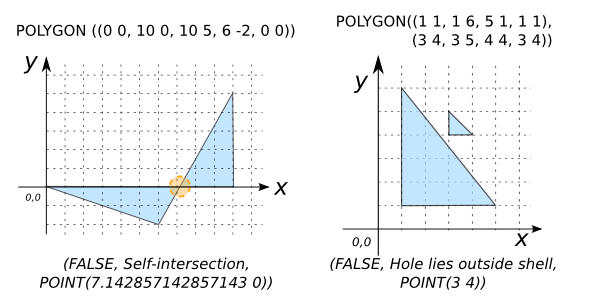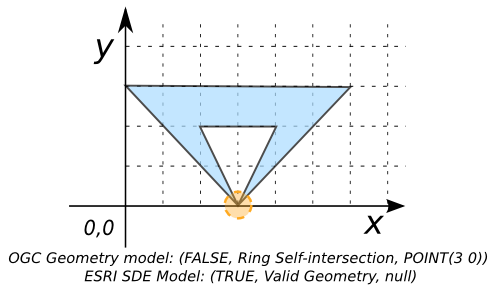ST_IsValidDetail
Signatures
ARRAY ST_IsValidDetail(GEOMETRY geom);
ARRAY ST_IsValidDetail(GEOMETRY geom, INT selfTouchValid);Description
Returns an H2 ARRAY containing 3 elements describing whether
geom is valid:
- A
BOOLEANstating whethergeomis valid or not - The reason why
- The error location, or
NULLifgeomis valid
Optional variable selfTouchValid sets whether polygons using
self-touching rings to form holes are reported as valid. If this
flag is set, the following self-touching conditions are treated as
being valid:
- The shell ring self-touches to create a hole touching the shell
- A hole ring self-touches to create two holes touching at a point
The default of 0 (following the OGC SFS standard) is that this
condition is not valid. Set it to 1 to consider it valid (c.f.
ESRI SDE model).
Examples
SELECT ST_IsValidDetail('POLYGON((210 440, 134 235, 145 233,
310 200, 340 360, 210 440))');
-- Answer: (TRUE, Valid Geometry, NULL)
SELECT ST_IsValidDetail(
'POLYGON((0 0 1, 10 0 1, 10 5 1, 6 -2 1, 0 0 1))');
-- Answer: (FALSE, Self-intersection, POINT(7.142857142857143 0 1))
SELECT ST_IsValidDetail('POLYGON((1 1, 1 6, 5 1, 1 1),
(3 4, 3 5, 4 4, 3 4))');
-- Answer: (FALSE, Hole lies outside shell, POINT(3 4))
-- The next two examples show that the validation model we choose
-- is important.
SELECT ST_IsValidDetail(
'POLYGON((3 0, 0 3, 6 3, 3 0, 4 2, 2 2, 3 0))', 0);
-- Answer: (FALSE, Ring Self-intersection, POINT(3 0))
SELECT ST_IsValidDetail(
'POLYGON((3 0, 0 3, 6 3, 3 0, 4 2, 2 2, 3 0))', 1);
-- Answer: (TRUE, Valid Geometry, NULL)
